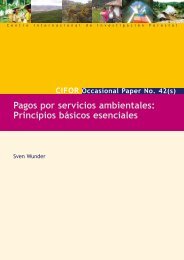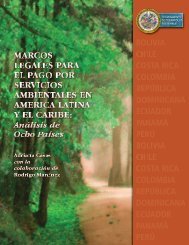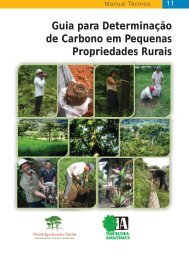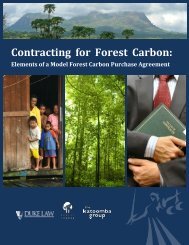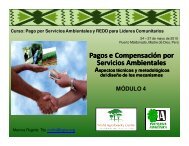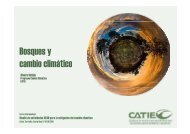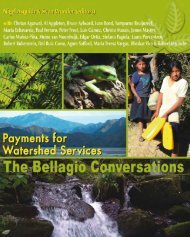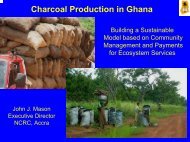Guide on Climate Change and Indigenous Peoples
Guide on Climate Change and Indigenous Peoples
Guide on Climate Change and Indigenous Peoples
- No tags were found...
Create successful ePaper yourself
Turn your PDF publications into a flip-book with our unique Google optimized e-Paper software.
“leakage,” difficulty in accurately m<strong>on</strong>itoring improved performance,permanence or the need to ensure that forests that have c<strong>on</strong>tributed toemissi<strong>on</strong>s reducti<strong>on</strong> remain intact over time.• Scale – Nati<strong>on</strong>al, sub-nati<strong>on</strong>al or <strong>on</strong> a per project basis? How abouta regi<strong>on</strong>al approach? If REDD is d<strong>on</strong>e <strong>on</strong> a sub-nati<strong>on</strong>al basis or <strong>on</strong> aper-project basis, leakage in other areas might cancel out emissi<strong>on</strong>sreducti<strong>on</strong>s that have been gained. The same case with forests whichcut across nati<strong>on</strong>al boundaries, e.g., C<strong>on</strong>go Basin, Mek<strong>on</strong>g Regi<strong>on</strong>, etc.For example, REDD gains achieved in the Democratic Republic of C<strong>on</strong>gowill be canceled out if deforestati<strong>on</strong> c<strong>on</strong>tinues in Camero<strong>on</strong>; gains inVietnam can be canceled out if the forests of Cambodia get deforested.For indigenous peoples, however, sub-nati<strong>on</strong>al scale <strong>and</strong> project-scale ismore appropriate because their territories are usually at a sub-nati<strong>on</strong>allevel. If the scale is just nati<strong>on</strong>al, then there is a big risk that they will beexcluded in decisi<strong>on</strong>-making.• Definiti<strong>on</strong> of forests <strong>and</strong> of forest degradati<strong>on</strong> - What are forests?Are plantati<strong>on</strong>s c<strong>on</strong>sidered forests? Is the FAO definiti<strong>on</strong> of forestsacceptable? What other definiti<strong>on</strong>s can be used, if FAO definiti<strong>on</strong> is notgood enough? Are peat or mangrove forests included in REDD? What isforest degradati<strong>on</strong>?• Role of the UNDRIP in the design, implementati<strong>on</strong> <strong>and</strong> m<strong>on</strong>itoringof REDD – The UNDRIP has to be <strong>on</strong>e of the main policy frameworkswhich will underpin the design, implementati<strong>on</strong> <strong>and</strong> m<strong>on</strong>itoring ofREDD. This means that REDD projects should respect the UNDRIP. Howwill this be ensured?What is the Phased Approach for REDD+?How does this relate to funding?This proposal was presented by Norway <strong>and</strong> has gained support from manytropical forest countries <strong>and</strong> d<strong>on</strong>or countries. It delineates which part ofthe REDD work will be funded by public funds <strong>and</strong> from market-basedfunds. The key principles are:• effectiveness - Is it achieving emissi<strong>on</strong>s reducti<strong>on</strong>s?• efficiency - Is the target achieved with the least cost?• equity <strong>and</strong> multiple benefits - Are benefits distributed equitably <strong>and</strong> arethe other benefits, i.e., biodiversity c<strong>on</strong>servati<strong>on</strong>, rights of indigenouspeoples' respected, am<strong>on</strong>g others, also achieved?Phase 1 – Building a REDD+ Strategy• Also called Readiness Phase where countries who volunteer to doREDD will lay the basic foundati<strong>on</strong>s <strong>on</strong> the ground. This means94 <str<strong>on</strong>g>Guide</str<strong>on</strong>g> <strong>on</strong> <strong>Climate</strong> <strong>Change</strong> <strong>and</strong> <strong>Indigenous</strong> <strong>Peoples</strong>



